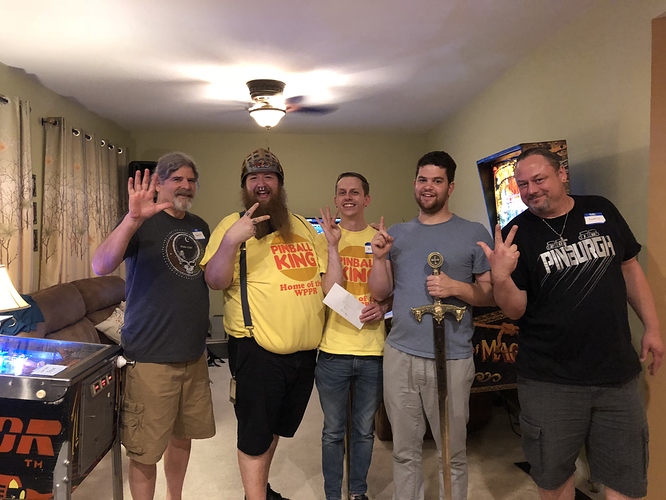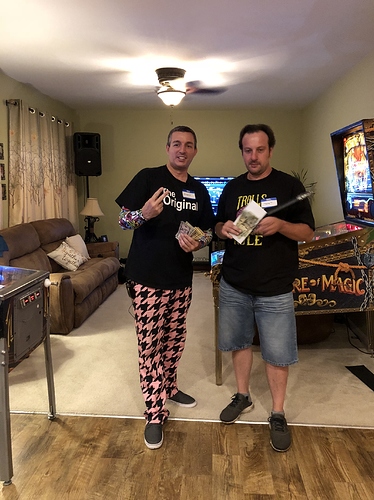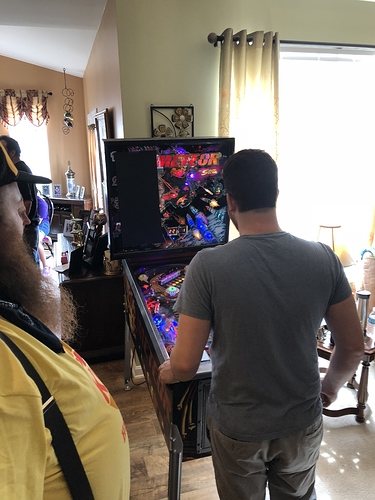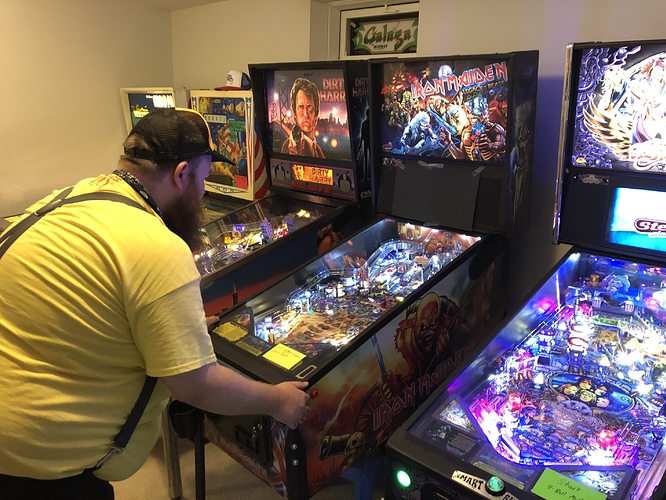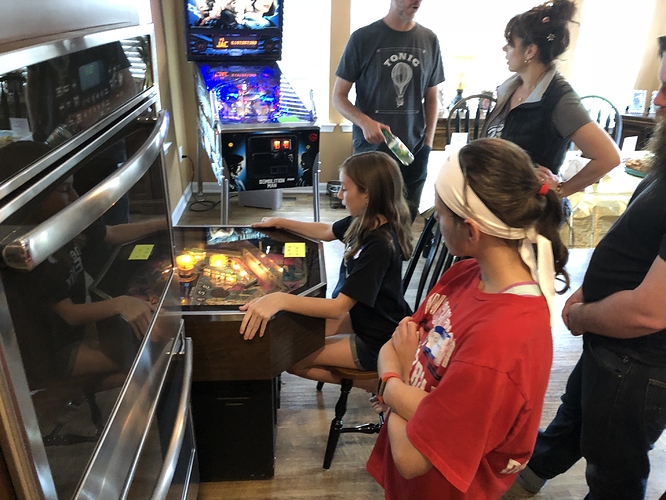Thanks for the feedback! I only do this stuff for all of you, the players. When I decided to start running tournaments in Delaware last September, I set out to offer the players the best experience around (even though I really didn’t have a clue as to how to run a tournament). I want Delaware to be THE place to go to play in a quality pinball tournament. I also don’t try and get complacent and I’m always trying to improve the entire FSF experience. Stay tuned as there is even more to come for 2019, perhaps a 24 hour event!
Quick question for those of you that have run Critical Hit tournaments with a Finals. I know cards can be played in the finals, but do you still allow the game bounties to be earned for additional cards or is the only time you can earn additional cards is through the qualifying rounds?
What a tournament! A Critical Hit tournament definitely brings a lot of excitement and insanity into the mix. You never know when someone is going to cast a spell to totally disrupt things! Below is a quick recap of the winners along with pictures! Our “A” division finals went down to wire, on the final game in their bank one of the players played Darkness, so our champion was crowned without ever seeing their score!
“A” Division Winners
1st - David Schumeister - $175 plus a 4 foot sword!
2nd - Matt Gusler - $100
3rd - Scott Wilson - $50
4th - Brian Thomas - $30
5th - Dennis DeLong - $23
“B” Divsion Winners
1st - Pete Tsipouras - $100 plus a dagger!
2nd - Chad Hastings - $50
50/50 winner of $93 - Scott Wilson
Thanks again to all 30 participants who played in today’s tournament! Also special thanks to Joe Fox Sr, Pete Tsipouras, and Brian LeBlanc for donating games for today’s lineup. Also special thanks to Vic Scelba who donated $25 to the prize fund! And one more shout out and thanks to Chris Thomas for helping me run this crazy tournament! Last but not least, the best baker around, a big thanks to my wonderful fiancé Marianne Pangia!
Here is a quick recap of the match play Critical Hit tournament I ran on 9/22. I wanted to share my thoughts with everyone to try and gain additional feedback from other TD’s who have run Critical Hit tournaments.
- I used matchplay software to run the tournament
- Format was group match play with 7 rounds of qualifying
- 2 cards were given out during registration
- Matchplay software was setup to randomly group players. From there I had each group step up to the table and had all 4 or 3 players roll a D20 to determine game and machine. This was cumbersome and lengthy at times. During round 3, we had 3 insanity cards played, which meant I had to perform the above process a total of 4 times. In the future I will have the software automatically pick machines, and when insanity is played I will let the software redraw all of the machines in seconds
- We had no issues announcing the start and end of phases.
- We only had a couple of instances where players played a spell card at the wrong time or target.
- For darkness, I had already pre-cut 15 pieces of black poster board to match up with the displays of all 15 machines. I then placed each pre-cut of paper underneath of the machine, that way when Darkness was played I didn’t need to be involved. The group simply grabbed the tape (I had 4 rolls of scotch tape spread out the room), and taped the poster board over the scores. Only once did a group request a TD to peek behind the poster board to confirm the correct player was up, which they were. No one played out of turn during a darkness game.
- We had 30 players. Top 16 made finals. Each player that made finals got an additional card
- Since I was unsure what to do in the Finals, I announced that no additional cards could be earned in Finals through the bounties on each game. Still undecided here and want to hear feedback from other TD’s and what they do
- Finals ran longer than my normal tournaments, possibly because of how I ran the Critical Hit Finals and not knowing exactly what to do. Typically in my standard tournaments, once “A” division has picked their banks I let them go and play their games. However, since some cards have global effects, I decided that all 4 groups in the finals had to wait after each game before starting a new one, in case another group wants to play a spell card. Looking for additional feedback here as well. Is this the correct thing to do? Should you just let the groups do their thing and the only cards that matter are local cards? Do you let cards from the “B” division effect the “A” division players?
- We had one instance where numerous cards were played and the ruling was confusing to make. Someone played a card to swap scores. The victim played a local shatter. Another player in that same group then played a global shatter. The thought process we had was that once the first card was played and it was shattered, both cards fizzled out. Which meant that the global shatter card also fizzled since there was nothing for it to apply to. Thoughts on this?
Overall, everyone really enjoyed it. The event ran a bit too long, but that’s an easy fix the next time around.
I am running a match-play version this Saturday @ Mystic pinball in MA and have run 2 knock-out versions before: https://www.facebook.com/events/633376637054959/?ti=cl
-
I am also using matchplay
-
Same though I will stop play via time and decided if another round can be fit or break for lunch
-
This was the original plan, but I am wondering if I should do what I did in knockout to help out less experienced players with 1 card for under IFPA rank 250/500 and 2 for above. What do you think? We are also having it so each player can buy 1 card for a $20 donation to project pinball.
-
I am basing my tournament off the one that Karl ran, which he used Tiered Swiss (still not sure how that is different from Swiss) For game selection it will be random unless when groups roll for order someone gets a 20, then they can pick an available game. If insanity is played, the entire round will be redrawn as changing just the games is not currently possible. This seems the easiest way to handle this.
-
We had special Tin’s made that hold the cards and have a reference sticker on the inside of it to help with people following along with the phases, hope it helps.
-
What was the ruling for this? Did you let them keep it or did you make them discard?
-
We had 2 poster boards made so that we can cover the entire backbox of any game, which will mean only 2 darkness can be cast each round. What you did is not a bad idea but we wanted to avoid using tape, so we have rope and weights attached the boards. All cards played on darkness games were done so before scores were revealed right?
-
We will have the most make finals as allowed by ifpa (no more then 50%) so 16 would require 32 and we are not quite there yet. If not we would do top 12 with byes. Instead of giving everyone a free card who makes finals, we are allowing an additional opportunity to buy a card for 20.
-
Based on what Karl did, bounties stayed during finals, which I am not sure about what I am going to do yet. Because he allowed game choice during finals so it might cause people to pick specific games for card earning issues. How did you handle game choice? Did top seeds in group get choice of games or was that all decided by roll as well?
-
We will only be running 1 division, which is how I ran the other ones as well…Mainly because I cant imagine running 2. Running this type of tournament is hard enough, let alone if you double up on how difficult it would be lol. I try and simplify it down as much as I can, maybe with more help it could be run with 2 divisions but I think we would need many more players.
-
I believe the guide says it is all a first in first out order when it comes to playing cards, so I think you handled that right. It is one of the grey areas in the format for sure, the added complication of the fact play immediately cards get resolved in opposite order…I think?
-
How many goals did you have? Did every game have one?
I am certainly stressed about running it, as a lot can go wrong and it is a ton of responsibility to run. Hopefully it will go well and I prep as much as I can to predict any issues that might come up.
I think you should go with whatever’s posted on FB and/or the IFPA site, unless there’s an unavoidable reason that forces a change.
Ya I guess it is a see how this goes and change for next time thing.
Answers are in BOLD above.
That doesn’t make any sense. If it was first-in first-out, then shatters would do nothing since the first card would resolve and the shatter would have nothing to shatter.
If CH follows normal CCG rules like I expect, then the thought process should be:
- Spell is cast. It is now the top spell on the spell stack.
- If no one modifies the top spell on the stack, then the stack starts resolving in top-down order. Most of the time this will be a single card.
- If someone does modify the top spell on the stack, such as a Shatter or future spell-modifying card, go to #2 with the modifying spell as the new top spell on the stack.
So we have a stack of: Swap Scores, Local Shatter, Global Shatter. In reverse order then, the Global Shatter shatters the Local Shatter, leaving Swap Scores which then resolves.
This would be exactly the same as, for example, Magic: The Gathering if someone cast a spell, then a Counterspell, then another Counterspell.
I believe that makes perfect sense. With that said, following that process means we got the ruling wrong. Agree?
I’d say in this case, yes. But that’s not meant to be taken negatively; this sort of thing is confusing to people without a CCG background, almost all of which use the LIFO spell stack mechanic. We recently did a CH tournament locally and it was the first one for all of us, with plenty of head scratching over card wordings. We leaned heavily on our CCG experience to figure out what the likely intended effect should be.
IMO, the tournament guide making reference to some things being FIFO and some thing being LIFO is adding unnecessary confusion. Mechanically, everything is LIFO. If you have 3 normal cards being played (i.e, no shatters) then this appears to be FIFO, but mechanically it’s just 3 LIFO spell stacks of size 1.
Example: Someone plays Darkness, someone else plays Confusion, a third person plays Forbiddance. This isn’t one stack resolved FIFO, it’s three size-1 LIFO stacks. Technically, Confusion doesn’t exist until Darkness resolves, and Forbiddance doesn’t exist until Confusion resolves, but unless someone is jumping in there with late shatters or something, it doesn’t really matter.
Spell stack of size one is probably a much better way of describing it. When I wrote those descriptions of LIFO / FIFO I was trying to resolve how Karl designed and thought of the strikes cards, with my desire to change everything to explicitly follow magic’s spell stack rules. Since Karl didn’t have years of wasted time and money playing magic through highschool to draw on, he didn’t design things the way I would have, which is fine. I thought it was important for TDs to think about resolution instead of arguing when it came up.
I have been a little lazy about accepting edits on the original strikes doc I wrote, but if it is still getting read I would be happy to have someone try to improve this to be less confusing.
So in a crit hit environment, how would you accept card playing? What system would you use to collect/cast spells? Have people come to the front and place their card down?
There was also a second case where an initial card was played by player 1 (I don’t remember what), followed by a Shatter by player 2, followed by a shatter by player 1. IIRC, the correct call was made in that case, where the Second Shatter countered the First Shatter, leaving just the initial card to resolve. This instance was in the first round of A Finals.
In any case, I thought the tournament was a ton of fun (am I biased?) and you ran it great, as usual. Great mix of games, everyone having fun and keeping it casual.
The only suggestion I would make would be to print out a few copies of this: https://www.neverdrains.com/criticalhit/images/2017allCards.jpg so all the players can look into what cards might be around. Having an idea of the availability of cards would also be a nice addition, i.e. knowing there are 8 darknesses, 4 bootstrap paradoxes, etc. in the complete deck.
Depends on the phase. Here’s what we did, which worked pretty well:
If it’s the beginning of a round and no pinball is being played yet, then I would have the players together and ask if anyone wants to play a card. If so, resolve it, then ask again. Once no more cards are played, start the actual “playing pinball” part.
During play, the few cards that can be played during a round are a free-for-all. Cast them at will and groups resolve them on their own, or ask the TD for clarification if necessary. For anyone holding a global shatter, it’s on them to find something to shatter if they want, since it’s impractical to announce every single card being played while everyone is on machines.
After pinball playing is done (or after individual games are done, as practical) ask for any “after round” cards like Heal. If anyone wants to play one, resolve it and ask again until there are no more. This completes the round.
I ran mine pretty much like Dave mentioned above. I had games on 2 floors, so at the start of the tournament and at the end of every round I announced Phase 1, at which time at least 1 person usually played a card. After about 5 seconds I would announce last chance to play cards in Phase 1, followed by 3,2,1, phase over. Once Phase 2 started with actual game play, the groups moderated card spells themselves unless they needed the help of a TD. Once everyone finished all games we gathered upstairs and announced last chance to play cards with a 3,2,1 countdown.
After that we handed out any bounty cards that were earned and every couple of rounds we have our random cards during this time.
One thing I forgot to mention about the bounties. I made it clear to everyone that your earned bounty had to be witnessed by players in your group. This kept everyone honest and worked well.
Quick question on a couple of cards.
Modica Plague - This has to be cast by a player who is playing on the machine they wish to infect. After the round is finished, the game is infected and removed from the tournament. Is that correct? We had a player that played the card, expecting it to immediately knock his assigned machine out of the tournament, causing a random redraw of arena. I say it can’t work that way, mostly for reasons of time - I can’t have a player wait until player 4 ball 3 is draining, realize they have lost, and then “infect” the machine and get a new arena and game.
Darkness - Once the game ends, the cover comes off the backbox, yes? And so at that point, someone can play a Heal spell? Does the darkness cover go back on the game for the extra ball by spell? Last week I said Yes, but now I am thinking that No, the Darkness ends at the end of the game, which is when Heal is cast, “at end of game”. So Darkness ends, and then the player gets their extra ball if cast with no darkness.
For Modica, the game is removed after everyone finished the current game. It does not force a redraw.
For your Darkness scenario, I agree. Scores are revealed at the end of the game. If a Heal spell is cast, they play the game as it lies unless another Darkness is cast.
I happened to discuss these two situations with Doug privately, so I thought I would echo my thoughts here since I disagree with both of these. Of course, this is just how I view the cards, any official rulings from the deck creator(s) would still apply.
This means that the caster of Modica Plague gets zero benefit from this card on their current game. What’s the point of the card then, especially considering the very real possibility you’ll never be drawn on that game again anyway? This interpretation makes this card as worthless as Whisper, and it gets even more worthless the deeper you go in the tournament.
My position on this is that Heal is a continuation of the current game, and Darkness applies for the current game. The game was over, so Darkness comes off, but the game was then extended so it’s back on, and Darkness goes back on.
Karl says…
I would think this means the game gets pulled once the players are finished. I think this is still a powerful and valuable card. I would play it to remove a Stern Star Wars asap… hopefully before I ever took a draw into it.
